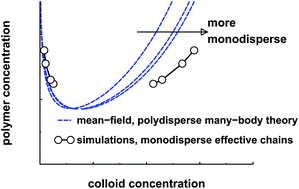A simple many-body Hamiltonian for polymer–colloid mixtures: simulations and mean-field theory
Abstract
We investigate depletion interactions between inert hard colloids in the presence of ideal

a Theoretical Chemistry, Chemical Centre, P.O. Box 124, Lund, Sweden
b School of Physical, Environmental and Mathematical Sciences University College, University of New South Wales, ADFA, Canberra ACT, Australia
We investigate depletion interactions between inert hard colloids in the presence of ideal

 Please wait while we load your content...
Something went wrong. Try again?
Please wait while we load your content...
Something went wrong. Try again?
J. Forsman and C. E. Woodward, Soft Matter, 2012, 8, 2121 DOI: 10.1039/C2SM06737D
To request permission to reproduce material from this article, please go to the Copyright Clearance Center request page.
If you are an author contributing to an RSC publication, you do not need to request permission provided correct acknowledgement is given.
If you are the author of this article, you do not need to request permission to reproduce figures and diagrams provided correct acknowledgement is given. If you want to reproduce the whole article in a third-party publication (excluding your thesis/dissertation for which permission is not required) please go to the Copyright Clearance Center request page.
Read more about how to correctly acknowledge RSC content.
 Fetching data from CrossRef.
Fetching data from CrossRef.
This may take some time to load.
Loading related content
